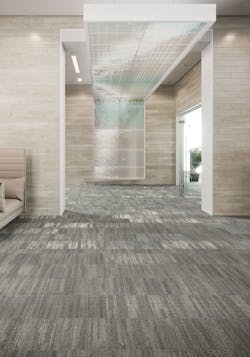Biomimicry: Taking Cues from Nature to Create More Sustainable Products and Interiors
Whether we are conscious of it or not, research shows that when our interior environments mimic the colors, patterns, textures and layouts that we see in nature, our minds make those connections resulting in positive effects for both mental and physical performance (known as biomorphic design). But when they take a step further to actually imitate how nature works, it can support the environment as well as user health (biomimetic design). Here, we speak to professionals making strides in both.
The Practitioners
The Biomimicry Institute—a non-profit cofounded by the legendary Janine Benyus and Bryony Schwan—defines biomimicry as: “a practice that learns from and mimics the strategies found in nature to solve human design challenges—and find hope.” The Institute offers a variety of resources and initiatives to support professionals and startups that are trying to utilize the same methods that live systems in nature do. This can help them innovate in sectors that range from construction to agriculture, fashion, energy, chemistry, transportation materials and more.
“Nature designs things without causing harm,” said Jean Hansen, interior design sustainability principal with HDR, citing the example of a hypothetical adhesive mimicking the microscopic hairs on the bottoms of a gecko’s feet that allow it to climb a vertical wall without falling. “The gecko doesn’t leave behind anything toxic that can harm it or something that comes after it.”
One of the Biomimicry Institute’s teaching sites, AskNature.org, offers even more in-depth examples, including an office complex in Zimbabwe designed by architect Mick Pearce and engineers at Arup Associates that boasts an internal climate control system built off the structure of termite mounds, which results in 90% less energy used for ventilation than similar projects its size.
This is accomplished thanks to the work of Werewool, a fashion-meets-biotech startup designing a way to create biodegradable fibers by identifying protein structures found in nature, such as the red fluorescent protein found in some species of a coral relative called Discosoma. They grow fibers that are reliant on these proteins and create textiles that don’t need toxic dyes and/or petroleum-based synthetics (which the global textile market is dependent on and unfortunately accounts for 35% of global microplastic pollution).
Bill Browning and the other co-founders of sustainability consulting firm Terrapin Bright Green are utilizing biomimicry on an ecosystem scale, having developed a suite of ecological design services they’ve dubbed “Phoebe” (after a group of North American songbirds that have adapted to human development by nesting in bridges, buildings and other structures). They use certain metrics pulled from both the history and current needs of a project’s local ecosystems to achieve regenerative design.
One of their initial efforts started in 2010 with a project in New York state, under the New York State Energy Research and Development Authority’s (NYSERDA) bioinspired innovation program. Check out more information and findings from this collaboration in Terrapin’s report, Tapping into Nature, on terrapinbrightgreen.com.
Utilizing The Mannahatta Project—a study led by the Wildlife Conservation Society that recreates the landscape and ecology of the island of Manhattan as it was back in the 1600s—Terrapin was able to determine why a building that was buying 51 million gallons of water a year was putting 90 million into the sewer. One of the original streams of Manhattan was under the building, and for more than 80 years had been pumped into the storm drains. After a tenant purchased the building, they worked together to create the performance goals that would eventually become Phoebe.
The data centers housed there also gave it an 85,000-ton carbon footprint. When the site had been intact forest with the stream running through it, it would have been sequestering 3.7 tons of carbon a year. The long-term aspirational goal is to get the building back to the site’s original carbon balance.
“It’s a forever project,” laughed Browning when discussing the cisterns, new glazing, new mechanical systems, green roofs installed and the other elements helping them reach that goal. “But the idea is asking can I, with the built environment, replicate the ecosystem services that would have been provided by the natural habitat on this site.”
The Products
This can apply to space planning with layouts that push the user to navigate through settings as they would if walking a path in the forest, rather than follow a straight line from one part of a building to another. “And we think about how that can be built into products—products that don’t align perfectly and bring in that typography and sense of landscape,” he explained, such as with soft seating that provides a variety of heights and shapes.
The Mohawk Group’s lens is a little more hyper-focused, this time on communities of lichens—organisms that can grow on branches and rocks, in a variety of different climates. They convert carbon dioxide into oxygen and can also absorb pollutants from the air. The recently released Lichen Community modular carpet collection builds off the original Lichen line, designed in collaboration with McLennan Design to mimic the growth patterns of unique lichen species. Lichen Community is dematerialized and utilizes EcoFlex One backing, making it net positive for both carbon and water, part of its achievements for Petal Certification from the International Living Future Institute.
But it’s their collection known as Data Tide that begs the next question for biomimicry.
The Next Steps?
“We need to start talking about our mixed presence,” said Hamilton of the workplace. With most employers (if not all) embracing some physical and some digital presence at the office, how will we ultimately accommodate that? “And how can we apply biomimicry to that?” he asked.
A side conversation to this is how to mix biomimicry and technology. And while it’s not a traditional biomimetic approach, Mohawk’s Data Tide takes a great stab at it by taking the data from three studies of “blue carbon” and running it through a data visualization software to create the line’s pattern.
“We were intrigued by the study of estuaries, and their unique habitat thanks to the convergence of both salt and fresh water,” said Mohawk’s Design Director, Royce Epstein. Carbon dioxide gets sequestered underwater in estuaries—known as “blue carbon”—by specific plants that grow there. “What was interesting was that the pattern had a gradient to it, and we wanted to make sure of that but the data visualization actually did it for us,” she explained. “We were careful to select colorways that played that up to better illustrate the color, light and shadow you might see in these waterways.”
About the Author

AnnMarie Martin
AnnMarie has been covering the commercial design space since 2005 and has been on the editorial staff at i+s since 2011. Her style and vision has helped the brand evolve into a thought leader in purpose-driven design and cultural movements shaping the way we live and work. She returned to the role of editor in chief at the start of 2023 and her journalism and fiction writing background have helped to craft bi-monthly issues that don’t just report the latest industry news, but tell a cohesive tale of some of the biggest topics facing designers today. She can always be reached at [email protected].

